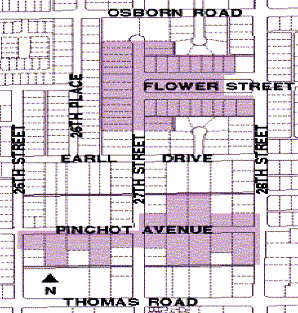
Phoenix
Homesteads Historic District
The
New Deal Resettlement Program
During the Great Depression, the Roosevelt
Administration was making a concerted effort to address
long-term land use planning while improving farm
production. One of the first steps taken was the
Agricultural Adjustment Act (AAA) of 1933, an allotment
plan to subsidize prices and reduce the disparity
between farming costs and income. However, a conflict
arose between the crop adjustment programs, which
required limited production, and the tendency of the
unemployed urban population to return to the land as a
means of survival in times of hardship. It became
necessary to control this "return migration" in order to
stabilize prices, especially in more rural areas. While
the government could not prevent citizens from farming
the land to survive, the Roosevelt administration
instead acted to reduce the amount of excess production,
which could drive prices down, in order to stabilize the
agricultural economy. The result was the Subsistence
Homestead Program.
Subsistence Homesteads
The National Industrial Recovery Act of 1933
established the Subsistence Homestead Program, described
as a 11 back-to-the-farm" movement. Existing farmland
was purchased and subdivided into one to five acre
farming plots. Low-income families were then relocated
to the tracts where they could offset the cost of living
by producing their own food. In order to keep production
to a minimum on these small farm cooperatives, sites
were chosen such that adequate non-farm employment was
available nearby and the homesteaders included in this
program had to be fit for industrial employment. While
part-time farming as an income supplement was not a new
idea, the American experience with organized,
collective, "garden home" developments were very
limited. As a result, the Subsistence Homestead Act
became a controlled experiment in land planning,
economics, housing design and social structure.
Despite
critical views that the program's collective nature was
"communistic fifty-eight resettlement programs were
planned for several areas of the country, ranging from
25 to 300 homesteads per project. Forty-three projects
were constructed. Only four of these were in the west:
El Monte, California; the California San Fernando
Valley; Longview, Washington; and Phoenix, Arizona.
The
Baxter Tract
In December 1933, Paul V. Fuller was selected
to administer the Subsistence Homesteads Program in
Arizona. He conducted extensive studies and in March
1934, announced that Arizona's first homestead site
would be in the Salt River Valley, near Phoenix. Four
miles northeast of downtown Phoenix, eighty acres
known as the Baxter Tract, were purchased and a local
corporation, Rural Homes of Arizona, was formed to
administer the project and coordinate financing through
loans from the federal government. The southern forty
acres were developed initially, with forty 3/4-acre
plots laid out. Construction began in March 1935, and
twenty-five homes were ready for occupancy by October.
This first project was typical of the Subsistence
Homestead Program. The size of the lots had been
carefully analyzed to be capable of producing a large
portion of the families' food without producing surplus;
the average family of five supplemented its income with
a garden, orchards, chickens and a cow. Participants in
the project also had to secure part-time employment in a
non-farm capacity.
The
Resettlement Administration
While construction on the Baxter Tract and
several similar projects like it across the country was
underway, the Roosevelt administration reorganized the
various agencies handling the rural resettlement
programs into one coordinated program, the Resettlement
Administration. The basic tenets of the Subsistence
Homestead Project were kept, but modified to emphasize
more densely clustered housing and larger blocks of
common area farmland. Additionally, a maximum age of 55
was set for participants. By mid1936, the Resettlement
Administration had approved 97 projects nationwide.
Three resettlement projects were operating in Arizona by
July 1936, including the original Baxter Tract. The
other two were Casa Grande Valley Farms, Inc., and
Arizona Part Time Farms, Inc. As a result of the
improving agricultural economy, these projects were now
encouraged to both provide subsistence for those living
in the project and operate as commercial enterprises.
Housing was designed for multi-family groups and the
remaining acreage devoted to cash crops such as cotton
or alfalfa. Although the size of each individual home
lot decreased, the average acreage increased to five
acres per family.
Arizona Part
Time Farms, Inc. was approved to develop five sites in
the Salt River Valley: 210 acres in Chandler, 75 acres
at Indian School Road and 28th Street, 80 acres at
Northern and 51st Avenue, 60 acres at McDowell Road and
59th Avenue, and the remaining 36 acres of the Baxter
Tract. Each site would be made up of "units" consisting
of 15 to 25 multi-family grouping of houses, each
sharing common barns, poultry houses, milk sheds and
community buildings. The Chandler Unit of Arizona Part
Time Farms was incorporated separately in July 1937, as
Chandler Farms, Inc. However, the project and the
structures built for it no longer exist.
Of the other
four remaining sites, three were developed with housing
units. Twenty houses remain at the Northern and 51st
Avenue site. No houses remain at the McDowell Road and
59th Avenue site and no houses were ever built at the
Indian School Road and 28th Street location. Instead,
this area was used as pasture land for the dairy herd of
the Baxter Tract operation. The fourth site, the
remainder of the Baxter Tract, was designated Arizona
Part Time Farms Tract #2 and constructed between
October, 1936 and March, 1937; thirty-five homes were
built on small lots clustered in a T-shaped subdivision
focusing on a common area and community building.
Together with the first development, these two
subdivisions of Baxter Tract operated as one large
cooperative farm and survived to become the Phoenix
Homesteads Historic District.
The
Phoenix Homesteads Association
As each subdivision was built and occupied, the
Resettlement Administration provided for the creation of
"farm associations." The concept was to allow members of
the association to sell their "spare time" labor at
prevailing farm wages to the association to offset the
cost of living on the project. Profits were to be
divided equally among residents. The Phoenix Homesteads
Association was incorporated in August 1936, replacing
Rural Homes of Arizona as administrator of the Baxter
Tract. Each resident was required to join the
association and by March 1937, both phases of the Baxter
Tract were assimilated into the Association.
By 1939,
virtually all residents of the Phoenix Homesteads
project worked at full-time jobs and were unable to give
much time to cooperative labor efforts, although they
did tend their home gardens after work and on weekends.
This situation forced the Association to begin hiring
full-time farm laborers to tend the dairy herd and
poultry operations. This movement away from the initial
concept of a cooperative farm effort toward a more
commercial enterprise forced the federal government to
recognize these particular resettlement projects as
separate entities from the typical part-time farm
project. Consequently, federal administration of
resettlement projects whose residents were deriving
their primary income from non-farm employment was
transferred to the Federal Public Housing Authority. In
1944, an act allowing farm associations to repay the
purchase price of housing sold by the Resettlement
Administration was passed. By 1948, the Phoenix
Homestead Association had paid the indebtedness in full
to the United States, which released all interest the
government had in the property.
Building Styles in the Phoenix Homesteads Neighborhood
The initial phase of the Phoenix Homesteads
community was designed to accommodate single-family
homes on standard size subsistence farm lots.
Constructed of adobe, the simple homes were designed in
the Pueblo Revival style. Typically, they had flat or
low-pitched, tiled or slabstone roofs, irregular floor
plans and wide verandas. A significant part of the
building of the first phase was planting of street
trees, notably the Washington Palms and Aleppo Pines
which still line Pinchot Avenue today.
Although the
first phase was designed and developed locally, the
second phase of the Phoenix Homesteads community
was designed by engineers and architects employed by the
Resettlement Administration. Hence, the architectural
styles of tract *2 are representative of more uniform
public housing which was designed to emphasize economy,
uniform house plans, efficient heating and cooling, and
use of low-cost local construction materials. Like the
houses in the initial phase, homes in the Arizona
Part-Time Farm tract are principally constructed of
adobe. The Great Depression and the associated New Deal
programs had a significant effect on the development of
Phoenix. The Phoenix Homesteads District survives today
as a tangible link with this important early influence.
Of the original 60 homes built in the two phases of the
project, 45 remain and are excellent examples of adobe
construction.
The
Phoenix Homesteads Association continues to operate
today, making it the oldest continuously operating
homeowners association in the Valley. Many aspects of
its heritage remain, including the large lots, the
towering Aleppo Pines and Washington Palms, and common
area, which give the district a decidedly rural
character and make it one of Phoenix' most unique
neighborhoods.
Information, maps
and photographs provided courtesy:
Historic Preservation Office of the City of Phoenix
Neighborhood Services Department
200 West Washington Street
Phoenix, Arizona 85003
(602) 261-8699 |
 |

Laura Boyajian
Mobile: 602.400.0008
HistoricCentralPhoenix@cox.net
HomeSmart, LLC
5225 N. Central Ave. #104
Phoenix, AZ 85012
(602)
400.0008
|




